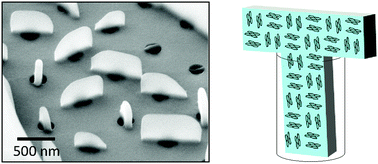Orienting and shaping organic semiconductor single crystals through selective nanoconfinement
Abstract
For organic semiconductor crystals exhibiting anisotropic charge transport along different crystallographic directions, nanoconfinement is a powerful strategy to control crystal orientation by aligning the fast crystallographic growth direction(s) with the unconfined axis(es) of nanoconfining scaffolds. Here, design rules are presented to relate crystal morphology, scaffold geometry, and orientation control in solution-processed small-molecule crystals. Specifically, organic semiconductor triisopropylsilylethynyl pyranthrene needle-like crystals with a dimensionality of n = 1 and perylene platelike crystals with n = 2 were grown from solution within nanoconfining scaffolds comprising cylindrical nanopores with a dimensionality of m = 1, representing one unconfined dimension along the cylinder axis, and those comprising nanopillar arrays with a dimensionality of m = 2. For m = n systems, native crystal growth habits were preserved while the crystal orientation in n = m direction(s) was dictated by the geometry of the scaffold. For n ≠ m systems, on the other hand, orientation control was restricted within a single plane, either parallel or perpendicular to the substrate surface. Intriguingly, control over crystal shape was also observed for perylene crystals grown in cylindrical nanopores (n > m). Within the nanopores, crystal growth was restricted along a single direction to form a needle-like morphology. Once growth proceeded above the scaffold surface, the crystals adopted their native growth habit to form asymmetric T-shaped single crystals with concave corners. These findings suggest that nanoporous scaffolds with spatially-varying dimensionalities can be used to grow single crystals of complex shapes.

- This article is part of the themed collection: 2021 Soft Matter Emerging Investigators


 Please wait while we load your content...
Please wait while we load your content...